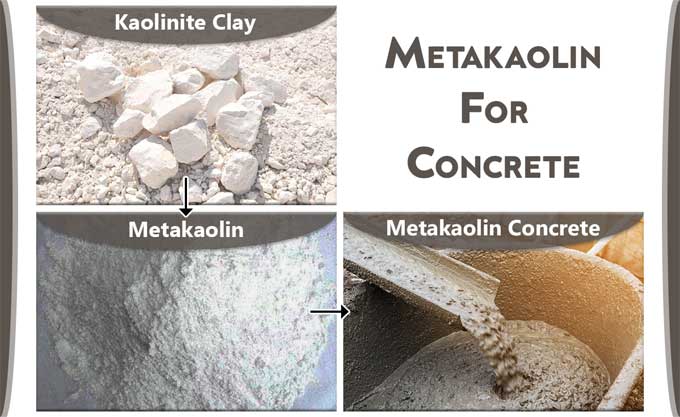
Metakaolin- How this helps in Strengthening the Concrete?

The structure is at its height in this period, and it is impossible to envision any construction without concrete. Any structure requires concrete as a fundamental component. Cement, sand, aggregates, and admixtures are combined with water to form concrete.
Concrete is without a doubt the most crucial building material for a structure's use and longevity, but it also has a negative side when it comes to environmental safety.
Finding a superior alternative that might be environmentally friendly and reasonable in every aspect has become critical and essential for researchers. As a result, they have begun to develop an affordable and environmentally friendly cement alternative that may partially replace cement minerals or raw materials without sacrificing the strength criterion.
Such ingredients can be classified as pozzolanic or mineral admixtures, extra cementing materials, or both. The purpose of this article is to explain metakaolin, one of the most often used supplemental cementing agents used to make high-strength concrete and enhance its durability.
Metakaolin Uses
Metakaolin is one of the most frequently used mineral admixtures nowadays and is a high-quality pozzolanic substance. It aids concrete in achieving greater efficiency and performance.
It is made particularly from premium kaolin, unlike other products, and is neither an industrial by-product nor only a natural substance.
By calcining pure or refined kaolinite clay at a temperature ranging from a particular centigrade, metakaolin is created. After the burning process is finished, the material is appropriately ground to the necessary fineness to enhance the concrete's different strengths and property characteristics.
The mineral kaolinite clay, which is fine and white in color, is used to make porcelain. China clay or kaolin clay are other names for kaolinite clay.
Similar to other mineral admixtures, metakaolin is made up of silica and alumina in an active state. At room temperature, it combines with calcium hydroxide to generate calcium silicate hydrate.
As a result, the concrete becomes more durable and its permeability is reduced. Now, when it is added to concrete, it will function as a filler, saturating the spaces between cement particles and making the concrete more impermeable.
Benefits of Metakaolin
The following benefits can be obtained by using Metakaolin:
1. Concrete's initial setting time is sped up by the inclusion of Metakaolin in concrete.
2. It aids in the growth of the concrete's early-age strength, enabling the early removal of formwork and so increasing the production pace.
3. By consuming calcium hydroxide, metakaolin stops the interaction between alkali and silica.
4. Drying shrinkage and efflorescence are decreased.
5. It makes concrete more water-tight and impermeable, making it safe to employ in offshore and water-retaining structures.
6. It can boost the refractory concrete's post-firing residual strength.
7. This allows for effective spraying.
8. It is an environmentally beneficial alternative and building material.
9. Compared to its competitors, it is more affordable.
10. It is more readily and abundantly available on the market than other mineral admixtures.
The above-mentioned advantages indicate that if taking these factors into consideration, it can almost be said that it overcomes all of the limitations of ordinary concrete and comes into play as a superior alternative.
Drawbacks of Metakaolin
The following drawbacks can be obtained by using Metakaolin:
1. Due to the fineness of the Metakaolin, it is necessary to use water reducers or admixtures that entrain air into the concrete as a means to make the concrete workable again, if the desired workability is not reached.
2. The following factors, however, can enhance performance:
A. The properties of the product must be maintained through increased quality control, and this control must be consistent to be effective.
B. A higher-quality material will likely be more expensive than a low-quality one, so selecting the right material is equally important.
Effect of Metakaolin
Workability: Due to the fineness of Metakaolin, the slump or workability of concrete is greatly decreased when the amount of Metakaolin is increased while maintaining the same water-cement ratio.
Nevertheless, if this new disadvantage is offset by using admixtures that reduce water consumption or by mixing fly ash with other materials in a mixture, it can be made up for.
Resilience: Due to the Metakaolin having a high pozzolanic impact as well as a filler effect, it is used in concrete to generate early-age strength.
Transparency: Due to the pozzolanic and hydraulic response, the use of metakaolin in concrete results in certain densification of the microstructure of the concrete and increases impermeability.
Applications of Metakaolin
1. Metakaolin is used while constructing dams, bridges, water retaining structures, off-shore structures, etc.
To learn more, watch the following video tutorial.
Video Source: American Concrete Institute
2. It is also used in high-rise buildings to achieve high-strength concrete.
3. It is used in the manufacturing of high-strength, high-performance, and lightweight concrete.
4. It is used in mass concreting.

Image Courtesy: gharpedia.com

